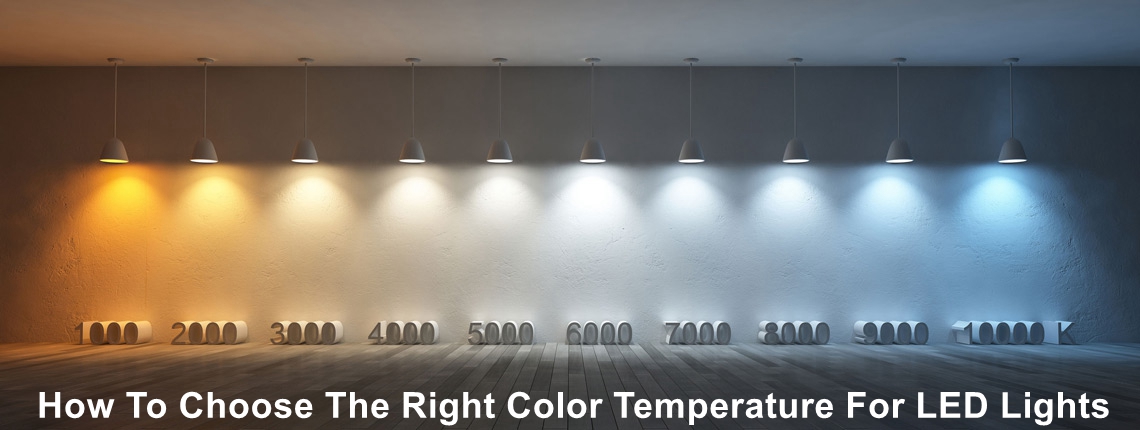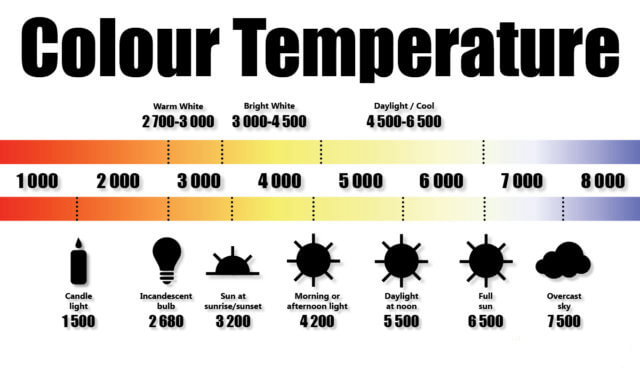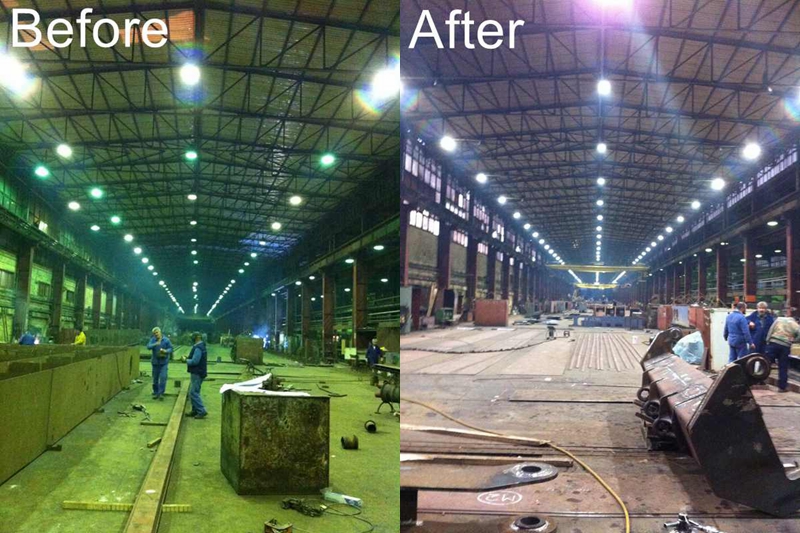
Choosing the right color temperature for LED lighting can be a confusing task for the average customer.
When buying LED lights to satisfy a particular space design, careful attention needs to be given to the color temperature, otherwise the final light output and effect will not be uniform and will fail to meet expectations.
Table of Contents [hide]
The Correlated Color Temperature, also short as CCT, of an LED light fixture defines the appearance (i.e., warm or cool lighting effect) produced by the light bulb. It should be mentioned that the value is not an indication of how hot or cool the bulb feels to touch.
Color temperature is measured in degrees Kelvin on a scale of 1000 to 10000.
Correlated color temperature represents the color of the light source, highlighting the warmth or coolness of the light. Understanding this value facilitates the choice of LED lights which match the exact setting and ambiance of the space.
The color temperature of LED lights has a major effect on the room where the lights are used. The value is measured in Kelvin with typical values for commercial and residential lighting ranging between 2000 & 6500K.
Heat from a light source produced by passing current reflects on the color effect of the light source and the change in heat is reflected in a change in the Kelvin value.
On the Kelvin color scale the low end of the spectrum is red, the middle is daylight, also referred to as neutral light, and the upper end is blue.
Reflecting this scale onto the output of a LED lighting fixture means a LED light with a Kelvin value at the lower end will appear red to yellow, giving a warm color output and a warm effect on the room, while a value at the higher end will give a bluish effect giving the room a cool effect.
For all the values on the spectrum, the change in color temperature does not affect in any way the led lights' physical temperature.
Color temperature chart reflects the color change on the Kelvin color scale caused by the change in the Kelvin degrees.
Choosing the right color temperature can make a huge difference in selecting a light that serves the purpose of the space.
The color temperature chart ranges from 1000K to 8000K, and shows values in degrees Kelvin, rounded up for ease of use:

Color Temperature chart
The color temperature chart is mirrored onto the LED Lighting color temperature ranges below, to give relevance between the temperature and the expected effect.
The degree values are included on the lighting package to assist customers in their selection.
1500K-1800K- Candlelight
1900K-3500K- Warm White
3600K-4500K- Natural White
4600K-5500K- Cool White
5600K-6400K- Cool daylight
6500K+ - Ultra daylight
Each room in the house and every space serves a different purpose, and the lighting requirements can widely vary from one space to another.
These factors are crucial to study while planning the lighting selection for a space and choosing the exact color temperature.
Below are some pointers to help define the space and choose the correct color temperature for a space.
What is the purpose behind the room?
As each room and space has a different purpose, it is essential to determine the purpose of the room and the kind of operation that will take place. Is the space a high end restaurant? A fast-food restaurant? A room for relaxation? An office? These questions will directly affect the color temperature to select for choosing the right lighting fixtures.
What kind of ambiance do I want to create?
How do you want people to feel when they walk into the room? Do you want to create a romantic or homely atmosphere? Is the setting work-related with a serious environment, or do you want to create a playful and energetic surrounding? Color temperature has a direct effect on emotions and using the wrong value can unintentionally create an undesired effect.
What is the intended look and style?
This is a more personal question, and relates to the design and style of the fixture and its overall feel. A number of other questions can also help in making the right choice such as the specific task the light has to serve, like reading, working or sleeping, or the effect the lighting will have on potential guests, whether it'll make them comfortable or tense.
These questions and pointers will help draw a clearer understanding of the type of LED light needed and the color temperature expected for the space.
2022 New Round LED Street Light With 3000K-6500K
As mentioned earlier, we usually call 2000K and 3000K LED lights as warm white LED lights, values of 3500K produce a neutral light, and lights with values 4000K and upwards produce a cool light, we call cool white LED lights.
Moving forward with this knowledge, as well as the pointers and questions detailed above, the below section defines a guide for choosing the right color temperature for specific types of spaces as well as recommendations for each.
Which ambiance we want to create?
What's the application of this room?
What's the style of the room interiors?
Office /Workspace
Workspaces require bright lighting to give a focused, alert, and productive ambiance. In such settings, it's recommended to use neutral LED lighting with a color temperature of 4000K. These are the most common LED lighting types for office spaces due to their versatility and ability to satisfy multiple uses.
Bedroom/ Sleeping room
This space is essentially designated for comfort, for relaxing and unwinding in a private environment. Bedrooms have a close connection to the occupants in terms of the effect they give their residents and the relation between the occupants and the room’s style and interior. It is therefore only natural to select a comfortable and warm color temperature lighting for this space, typically in a range between 2700K-3000K.
This range communicates directly with the light sensors in humans, which can detect differences between bright daylight and warmer tones that signify the day is coming to an end.
Warm color temperature LED lights prepare the brain for a good night's rest. Warm light bedside reading lamps are also recommended for directed nighttime readings.
Restaurant:
Choosing the right color temperature LED light for a restaurant is essential as it sets the mood and creates a specific atmosphere.
Fine dining restaurant: For a fine dining restaurant, warm color temperature LED lights are recommended with a range of 2500K-3000K to create a relaxed ambiance and enjoyable dining experience for customers. Different values can be used depending on the purpose of the space while maintaining values within the warm range, to ensure a homely feel and guaranteed comfort of the customers.
Fast food restaurant:
Customers of fast food restaurants on the other hand are not looking for ambiance or settings, they usually grab a quick bite and move on with their daily activities. Warm colors are recommended for fast food places, however with higher values than those for fine dining, ranging between 2700K-3000K. This range still ensures comfort for the customers, however does not give the relaxed feeling for customers to spend a long time, as the space is intended for short visits.
Hotels:
Color temperatures in the range 2700K to 3000K are recommended for hotels, specifically hotel rooms, to replicate lighting in the households of the customers, making it easier for residents to relax and fall asleep. Lobbies and corridors could be illuminated at the same values to maintain a warm feel throughout, or with brighter or neutral color temperatures to liven up the common spaces.

LED High Bay Light Project In Croatia
Color temperature is expressed in Kelvin and is a mathematical calculation based on a light source's Spectral Power Distribution (SPD). It enables a large range of unique color combinations. Different combinations of Correlated Color Temperature (CCT) and Color Rendering Indexes (CRI) are available in LED lighting, which can have different impacts on eyesight. The color temperature is measured in degrees Kelvin, with a warm light (yellowish) being around 2700K, neutral white being approximately 4000K, and cool white (bluish) being around 5000K or more.
Protecting the public with lighting that promotes alert drivers and a safe environment may be the greatest priority in many outdoor applications, to explain why it's necessary. In those circumstances, the suggested color temperature is used, taking into account the space and the people who will be using it.
Each LED module is driven by a constant current driver. In this type of system, the main supply generates an isolated fixed voltage of typically 24 or 48V that is low enough to comply with UL safety limits.
For AC drivers, there are narrow voltage (200-240VAC) drivers and wide voltage(90-305VAC) drivers. You could choose the suitable drivers according to the voltage of mains of the country you will install these LED street lights to.
Sometimes for industrial lighting, we also need to choose high voltage drivers with 347VAC, 480VAC or 528VAC.
The letters K, which stand for Kelvin and indicate the actual temperatures as determined by the Kelvin scale, stand for Warm White and Cool White. Cool White is closer to 5000k than Warm White, which is roughly 3000k. On a scale, warmer values fall lower and cooler values higher.
If you don't know which CCT to choose for your LED projector lights, pls contact us for professional advice.
Share the Post
Add: 1188 Jinxi South Rd., Linglong Industrial Zone, Lin’An - 311301, Hangzhou, Zhejiang, China
Copyright © Hangzhou ZGSM Technology Co., Ltd. All Rights Reserved
